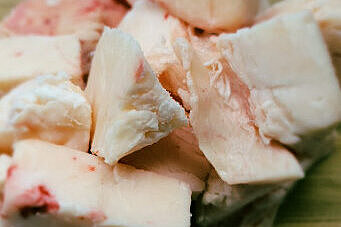Pork fat

What is pork fat?
Pork fat is a saturated fat consisting mainly of palmitic, stearic and oleic acid. It has a high melting point and is solid at room temperature. Pork fat has a characteristic taste and smell that many people and dogs find appetizing.
Pork fat can come from different parts of the pig, such as the back fat, the belly fat or the kidney fat. The fat content can vary depending on the origin. For example, back fat has about 80% fat, while belly fat has about 50% fat.
Pork fat can also be processed into lard by heating and clarifying it. Lard has a longer shelf life and a milder flavor than raw pork fat.
What are the benefits of pork fat for dogs?
Pork fat is a source of energy and essential fatty acids for dogs. Essential fatty acids are those that the dog's body cannot produce itself and must therefore obtain from food. Essential fatty acids include omega-6 fatty acids and omega-3 fatty acids.
Pork fat is rich in omega-6 fatty acids, which are important for, among other things
- skin and coat health
- the immune system
- hormone production
- wound healing
According to one source, pork fat, which is automatically absorbed when eating muscle meat, has a particularly favorable composition and contains many essential fatty acids.
What are the disadvantages of pork fat for dogs?
Pork fat also has some disadvantages for dogs that you should be aware of. Firstly, pork fat is very high in calories and can lead to overweight and obesity if consumed in excess. Obesity is a risk factor for various diseases such as diabetes, osteoarthritis and cardiovascular problems.
On the other hand, pork fat can be difficult to digest and lead to gastrointestinal problems. This is because pork fat has a high concentration of saturated fatty acids, which are broken down more slowly by the dog's body than unsaturated fatty acids.
In addition, too much pork fat can lead to inflammation of the pancreas (pancreatitis), which can be life-threatening. The pancreas produces digestive enzymes that break down fat in the intestine. If too much fat arrives in the intestine, the pancreas can become overloaded and digest itself. This leads to symptoms such as vomiting, diarrhea, loss of appetite, pain or fever.
Finally, pork fat can also trigger allergies or intolerances. Some dogs are sensitive to certain types of meat, including pork. Symptoms can include itching, skin rashes, hair loss, ear infections or gastrointestinal problems.
How much pork fat can a dog eat?
The amount of pork fat a dog can eat depends on various factors, such as the dog's size, activity level and individual needs. As a general rule, pork fat should only be fed in moderation to avoid the disadvantages mentioned above.
A rule of thumb is that around 10% of a dog's daily diet should consist of meat. The meat should be lean and contain as little fat as possible. If you want to feed your dog pork, you should cook it well and remove the fat. You should also avoid spices, salt or other ingredients that can be harmful to dogs.
If you give your dog ready-made food, you should make sure that it has a balanced composition and contains all the important nutrients. The ratio of omega-6 to omega-3 fatty acids should ideally be between 5:1 and 10:1.
Pork fat is an animal fat that has both advantages and disadvantages for dogs. It is a source of energy and essential fatty acids, but can also lead to obesity, digestive problems, pancreatitis or allergies. Therefore, you should only feed pork fat in moderation and pay attention to the quality and preparation. It is best to stick to a high-quality dog food that contains all the important nutrients and is tailored to your dog's needs.
If you notice any signs of hypersensitivity or poisoning in your dog, you should see your vet immediately. We are not a substitute for a vet, but we try to be as accurate as possible. Every dog reacts differently and we recommend you get a second opinion or consult your vet if in doubt.
Stay healthy and take good care of your four-legged friend!😊
Similar to Pork fat
Chicken fat is an important source of energy for dogs. It provides more than twice as much energy as carbohydrates or protein. This is particularly beneficial for active dogs that need a lot of...
Benefits of lamb fat for dogs Lamb fat can be beneficial for dogs in certain situations. For example: If the dog is very active and consumes a lot of energy, lamb fat can help to meet calorie...
Beef fat is the fatty tissue from cattle that is produced during slaughter. It contains mainly saturated fatty acids, which have a high energy density and can quickly give the dog strength and...
Animal fat comes from the tissue of mammals, poultry and fish. It consists mainly of saturated fatty acids, which are easier for dogs to digest than vegetable fats. Animal fats also contain...



